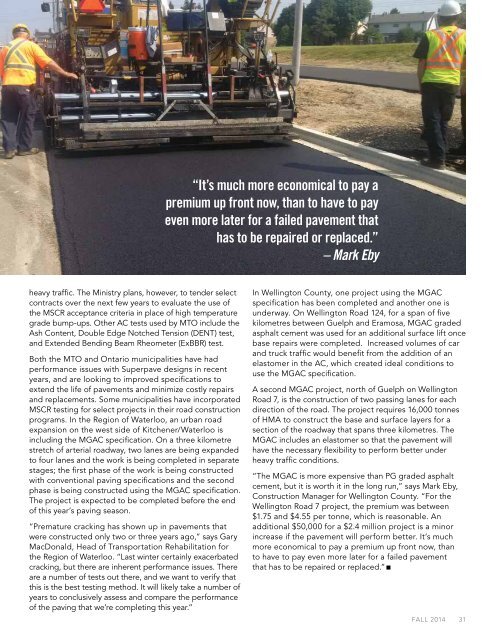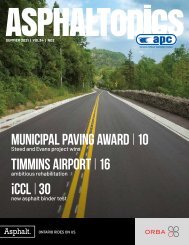ASPHALTopics | Summer 2014 | VOL 27 | NO3
Create successful ePaper yourself
Turn your PDF publications into a flip-book with our unique Google optimized e-Paper software.
“It’s much more economical to pay a<br />
premium up front now, than to have to pay<br />
even more later for a failed pavement that<br />
has to be repaired or replaced.”<br />
– Mark Eby<br />
heavy traffic. The Ministry plans, however, to tender select<br />
contracts over the next few years to evaluate the use of<br />
the MSCR acceptance criteria in place of high temperature<br />
grade bump-ups. Other AC tests used by MTO include the<br />
Ash Content, Double Edge Notched Tension (DENT) test,<br />
and Extended Bending Beam Rheometer (ExBBR) test.<br />
Both the MTO and Ontario municipalities have had<br />
performance issues with Superpave designs in recent<br />
years, and are looking to improved specifications to<br />
extend the life of pavements and minimize costly repairs<br />
and replacements. Some municipalities have incorporated<br />
MSCR testing for select projects in their road construction<br />
programs. In the Region of Waterloo, an urban road<br />
expansion on the west side of Kitchener/Waterloo is<br />
including the MGAC specification. On a three kilometre<br />
stretch of arterial roadway, two lanes are being expanded<br />
to four lanes and the work is being completed in separate<br />
stages; the first phase of the work is being constructed<br />
with conventional paving specifications and the second<br />
phase is being constructed using the MGAC specification.<br />
The project is expected to be completed before the end<br />
of this year’s paving season.<br />
“Premature cracking has shown up in pavements that<br />
were constructed only two or three years ago,” says Gary<br />
MacDonald, Head of Transportation Rehabilitation for<br />
the Region of Waterloo. “Last winter certainly exacerbated<br />
cracking, but there are inherent performance issues. There<br />
are a number of tests out there, and we want to verify that<br />
this is the best testing method. It will likely take a number of<br />
years to conclusively assess and compare the performance<br />
of the paving that we’re completing this year.”<br />
In Wellington County, one project using the MGAC<br />
specification has been completed and another one is<br />
underway. On Wellington Road 124, for a span of five<br />
kilometres between Guelph and Eramosa, MGAC graded<br />
asphalt cement was used for an additional surface lift once<br />
base repairs were completed. Increased volumes of car<br />
and truck traffic would benefit from the addition of an<br />
elastomer in the AC, which created ideal conditions to<br />
use the MGAC specification.<br />
A second MGAC project, north of Guelph on Wellington<br />
Road 7, is the construction of two passing lanes for each<br />
direction of the road. The project requires 16,000 tonnes<br />
of HMA to construct the base and surface layers for a<br />
section of the roadway that spans three kilometres. The<br />
MGAC includes an elastomer so that the pavement will<br />
have the necessary flexibility to perform better under<br />
heavy traffic conditions.<br />
“The MGAC is more expensive than PG graded asphalt<br />
cement, but it is worth it in the long run,” says Mark Eby,<br />
Construction Manager for Wellington County. “For the<br />
Wellington Road 7 project, the premium was between<br />
$1.75 and $4.55 per tonne, which is reasonable. An<br />
additional $50,000 for a $2.4 million project is a minor<br />
increase if the pavement will perform better. It’s much<br />
more economical to pay a premium up front now, than<br />
to have to pay even more later for a failed pavement<br />
that has to be repaired or replaced.”<br />
FALL <strong>2014</strong> 31


















